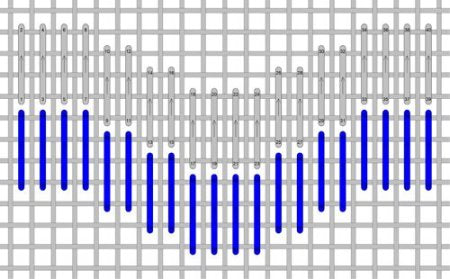The Best Four Needlepoint Stitches for a Hill or Mountain
Stitching a mountain, whether steep or just a hill, is a matter of slope. The stitch can make an area look flat, sloped or downright steep.
Eyeball the mountain you want to stitch. Is it a small hill or a steep mountain?
Misty Mountain (above) by JulieMar & Friends is a landscape design (5" x 5") that shows several stitches to use on slopes.
Which stitch is the best for the mountain slope on your design?
Great Needlepoint Stitches For Slopes
Here are four needlepoint stitches you can use on different slopes. Pick the one that best suits your canvas...
1. Bargello
The purple sloping hills in the background of this Lavender Fields needlepoint design by Maggie Co. are perfect for a Bargello stitch. Use one that goes up and down gradually like in this Bargello pattern.
2. Diagonal Cashmere
The Diagonal Cashmere needlepoint stitch is a great choice for a steeper hill.
This stitch was used in the Misty Mountain canvas above (on the middle mountain).

3. Diagonal Scotch Stitch
The Diagonal Scotch stitch has a slightly flatter slope than the Diagonal Cashmere. However, it complements the Cashmere stitch, so these two stitches make a great pair when you have two sets of mountains or hills, one in front of the other, like this Amalfi Coast design by Laurie Ludwin.


4. Diagonal Roumanian Stitch
Finally, you have a true mountain. It's steep and rocky, like those in Louise Marion's Mountain Lake design.
The Diagonal Roumanian needlepoint stitch is a great choice for steep mountains. You can go in either direction with this stitch, just follow the mountain slope. And, you can change the colors as you progress from the blue/purple mountains to the snow. (But keep each stitch component in one color: both the long diagonal line and the short crossing stitch).
This stitch was also used in Misty Mountain above (the top mountain range). The diagram below shows this stitch to the left, but you can also angle it the other way.

So, check out your mountain slope and decide which of these stitches is best for you.



